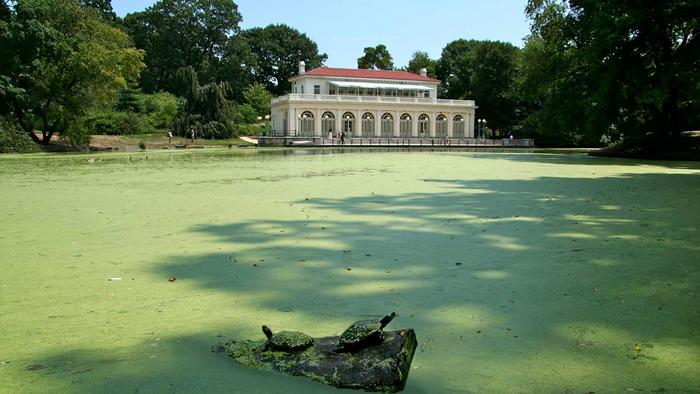Duckweed, a diminutive aquatic plant, has garnered increasing attention due to its remarkable resilience and potential applications in biotechnology and environmental sustainability. This unassuming plant, often found thriving in bodies of standing water exposed to sunlight, is recognized for its rapid growth rate and ability to absorb nutrients from its environment. Researchers at Cold Spring Harbor Laboratory (CSHL) have recently made significant advances in understanding the genetic makeup of various duckweed species, which could unlock vast opportunities for its utilization in agriculture, food production, and ecological restoration.
For decades, scientists have acknowledged duckweed’s potential in diverse fields, including bioengineering and water management. Its capacity to thrive in nutrient-rich environments, such as wastewater, and to absorb harmful pollutants makes it an attractive option for bioremediation. As our world grapples with climate change and environmental degradation, the exploration of sustainable resources becomes increasingly critical. Duckweed’s ability to serve as a bioindicator of ecological health further emphasizes its importance in environmental studies and restoration efforts.
The groundbreaking work conducted by CSHL researchers, particularly under the guidance of Professor Rob Martienssen and Computational Analyst Evan Ernst, has provided new insights into the genetics of duckweed. The team has been studying this plant for over 15 years and recently sequenced genomes from five distinct duckweed species. These genetic sequences are instrumental in understanding the unique traits that characterize duckweed, ultimately enabling scientists to engineer these plants for specific agricultural purposes, such as enhanced growth or nutrient uptake.
Martienssen highlights the significance of their findings, noting that the genome cataloging process utilized advanced genomic technologies that allow researchers to pinpoint which genes are present and which are absent in various duckweed species. A standout feature of their research is the identification of genes responsible for critical traits, such as the presence of stomata—small openings on the plant’s surface vital for gas exchange. These traits are particularly valuable for carbon capture applications, wherein plants play a substantial role in sequestering atmospheric carbon dioxide, thereby mitigating climate change impacts.
Under optimal conditions, duckweed is capable of farming itself, making it an ideal candidate for sustainable agricultural practices. By harnessing its ability to convert sunlight and carbon dioxide into biomass, researchers envision a future where duckweed can contribute to food and fuel production on a global scale. The high protein content found in certain duckweed species makes it a potential alternative for animal feed, while starch accumulation in others positions it as an attractive option for biofuel production, highlighting its versatility.
However, despite its promising attributes, duckweed agriculture remains in its infancy. Many commercial growers are currently experimenting with different duckweed species, assessing their suitability for local agricultural systems. The immense genetic diversity found within a single duckweed species reveals the vast possibilities for selective breeding and genetic modification. The comprehensive genomic understanding provided by Martienssen and Ernst’s research is anticipated to facilitate the development of tailored solutions that can address local agricultural needs and environmental challenges.
In addition to its commercial potential, the study of duckweed highlights significant evolutionary insights regarding its adaptation and diversification over millions of years. Martienssen and Ernst’s research indicates that duckweed species differentiated approximately 59 million years ago in response to historical climate extremes. Understanding this evolutionary history not only offers valuable lessons in resilience and adaptation but also sheds light on how these genetic adaptations may inform our approaches to contemporary challenges, such as food security and climate change.
Furthermore, the environmental implications of utilizing duckweed are profound. As a fast-growing plant that efficiently utilizes nutrients from wastewater, it could revolutionize the way we treat water while simultaneously producing food and biomass. This dual benefit positions duckweed as a critical player in fostering sustainable ecosystems and promoting circular economies that minimize waste and maximize resource utilization.
While duckweed is familiar within certain ecological contexts, increased public awareness and understanding of its benefits are essential. The narrative surrounding duckweed is rapidly evolving, transitioning from a mere nuisance in stagnant waters to a potential hero in our pursuit of environmental sustainability. As researchers continue to unravel the genetic mysteries of this tiny plant, the implications for agriculture, carbon capture, and ecosystem health increasingly become apparent.
The research conducted by CSHL serves as a beacon of hope for those advocating for innovative solutions to the pressing issues of our time. The potential applications of duckweed extend far beyond traditional farming practices, positioning it as a pivotal component of future sustainable food systems and environmental solutions. The scientific community, in collaboration with agricultural stakeholders, is tasked with exploring these possibilities, ensuring that duckweed achieves the recognition it rightfully deserves as a transformative force in a changing world.
As we look forward to the full realization of duckweed’s potential, it is imperative that policymakers, scientists, and the general public engage in discourse surrounding its applications. The successful integration of duckweed into existing agricultural and ecological frameworks could lead to tangible improvements in sustainability and resource management. By embracing the innovations made in genetic research and farming practices, society can work towards a future where duckweed serves as a symbol of environmental stewardship and resilience.
In summary, the duckweed research being spearheaded by CSHL represents a critical juncture in our understanding of this plant’s capabilities. The intersection of genetics, agriculture, and ecological restoration creates exciting avenues for exploration. As we harness the power of duckweed, we draw closer to a more sustainable future, one that recognizes the invaluable contributions of this tiny yet mighty plant to the health of our planet.
Subject of Research: Duckweed genetics and its applications in agriculture and environmental sustainability
Article Title: Unlocking the Potential of Duckweed: A Tiny Plant with a Big Future
News Publication Date: October 2023
Web References: Cold Spring Harbor Laboratory
References: doi.org
Image Credits: Evan Ernst/CSHL
Keywords: Duckweed, genetics, agriculture, sustainability, carbon capture, biofuel production, environmental restoration.




